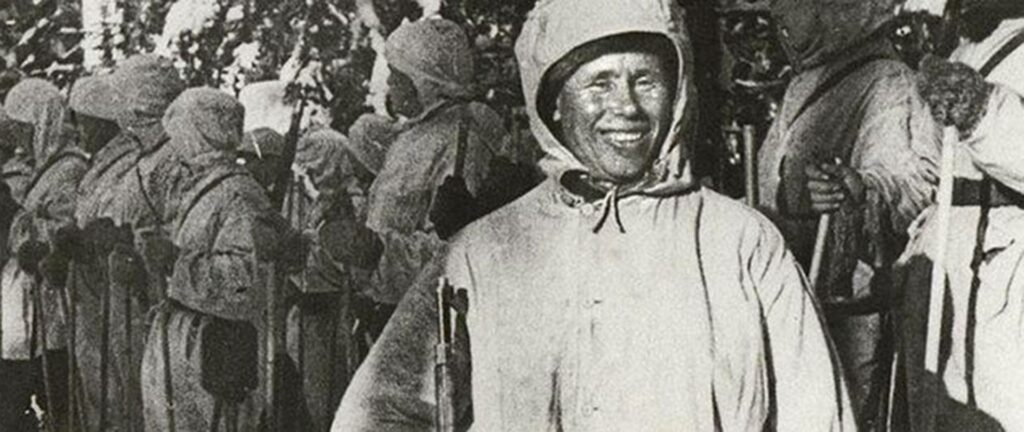Simo Häyhä also known as The White Death was a Finnish military sniper in World War II during the 1939–1940 Winter War against the Soviet Union. He is believed to have killed over 500 enemy soldiers during the Winter War, the highest number of sniper kills in any major war. Because of this, he is often regarded as the greatest sniper of all time.
Biography
Simo Häyhä was born on the 17th of December 1905 in Finland. He was the seventh of eight children in a Lutheran family of farmers. He also worked as a farmer, hunter, and skier prior to his military service.
Häyhä joined the Finnish voluntary militia Civil Guard at the age of 17. He was successful in shooting competitions and his home was reportedly full of trophies for marksmanship.
In 1925, at the age of 19, Häyhä began his 15-month compulsory military service in one of the Finnish Provinces. He also attended the Non-Commissioned Officer School and served as a conscript officer.
He, however, did not receive formal sniper training until a year before the war in 1938. According to his biographer Major Tapio Saarelainen, Häyhä once hit a target 16 times from 150 meters away in just one minute, during his civil guard training
Winter War service
Simo Häyhä served as a sniper in the Finnish Army during the 1939–40 Winter War between Finland and the Soviet Union. He was under Lieutenant Aarne Juutilainen in the 6th Company of Infantry Regiment 34 during the Battle of Kollaa.
Hayha was nicknamed “The White Death” by the Soviet Red Army due to his ability and the fact that he was dressed completely in white camouflage, during the war. According to reports, Häyhä dealt with the intense cold by dressing properly with multiple layers of clothing. He kept sugar and bread in his pockets, consuming them for the calories necessary to keep his body warm.
His slight stature of 160 centimetres (5 ft 3 in) assisted him in disguising his position. Hidden in a snow pit, he could lie still and observe the enemy for long periods of time. It was Häyhä’s custom to move, well before daybreak, to the position he had prepared, and stay there until after sunset.
He would frequently pack dense mounds of snow in front of his position to conceal himself, provide padding for his rifle, and reduce the characteristic puff of snow stirred up by the muzzle blast. He was known to keep snow in his mouth while sniping to prevent his breath in the cold air from giving away his position.
Read More:
- The Antwerp Diamond Heist: The Largest Diamond Heist In History
- Craig Price: The Youngest Serial killer In the History of The United States
- Timothy McVeigh: Most Notorious Domestic Terrorist In America’s History
Number of Kills
Häyhä’s division commander Antero Svensson credited him with 219 confirmed kills with a rifle and an equal number of kills by submachine gun, when he awarded Häyhä with an honorary rifle on 17 February 1940.
On 21 December 1939, Häyhä achieved his highest daily count of 25 kills. In his diary, military chaplain Antti Rantamaa reported 259 confirmed kills made by rifle and an equal number of kills by submachine gun from the beginning of the war until 7 March 1940.
Some of Häyhä’s figures are from a Finnish Army document, counted from the beginning of the war, 30 November 1939: 138 sniper kills as at 22 December 1939; 199 sniper kills as at 26 January 1940; 219 sniper kills as at 17 February 1940 and 259 sniper kills as at 7 March 1940. Rantamaa later in his book credited Häyhä with a total of 542 kills.
Häyhä never publicly discussed his total number of kills, but his own private memoir, discovered in 2017, states a number. He begins by stating that “this is his sin list”, and estimates the total number he shot to be around 500.
Injury and Exempt
On 6 March 1940, Häyhä was severely wounded after an explosive bullet fired by a Red Army soldier hit his lower left jaw. After the battle, as he appeared to be dead, he was placed on a pile of dead bodies.
A fellow soldier, under orders from his commanding officer, searched for Häyhä, noticed a leg twitching among the pile and found Simo Häyhä alive, although unconscious. He was evacuated by fellow soldiers who said that “half his face was missing”. The bullet had removed his upper jaw, most of his lower jaw, and most of his left cheek
Rumours of Häyhä’s death spread around in Finland and the Soviet Union. He however regained consciousness a week later on 13 March, the day that peace was declared. He spent 14 months recovering from his wounds and endured 26 surgeries.
Häyhä wished to serve in the Continuation War (1941–1944). However, he was excused due to the severity of his facial injuries, from which he was still recovering.
Honours
Simo Häyhä was awarded the First and Second class Medals of Liberty, as well as the Third and Fourth class Crosses of Liberty. As an additional honour, on 17 February 1940, he received a nameplated SAKO M/28-30 “Pystykorva” Honorary Rifle, donated by Eugen Johansson, a Swedish businessman and supporter of Finland.
Shortly after the Winter War, on 28 August 1940, Finnish Field Marshal Carl Gustaf Emil Mannerheim promoted Häyhä straight from alikersantti (the lowest military rank of a non-commissioned officer) to vänrikki (the first military rank of an officer).
In 1941, Häyhä was also nominated as a Knight of the Mannerheim Cross, the most distinguished Finnish military honour. He also received the Kollaa fighters’ medal. The Kollaa and Simo Häyhä Museum was opened in 1983, covering the Battle of Kollaa, and features a special permanent exhibition dedicated to the life of Simo Häyhä.
Häyhä spent his last years in a war veterans’ nursing home, where he died in 2002 at the age of 96. He was buried in his home town of Ruokolahti.


